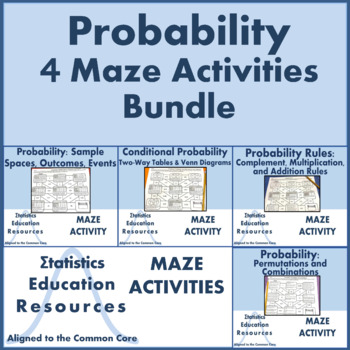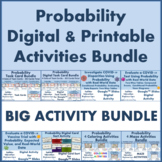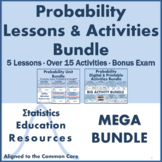Probability Maze Activities Bundle (4 Activities) (Common Core Aligned)
- Zip
Products in this Bundle (4)
Also included in
- This BIG bundle includes multiple printable and digital probability activities aligned with Common Core standards. Students practice solving problems on sample spaces, conditional probability, probability rules, permutations, and combinations in these maze activities. Students use both computation aPrice $34.99Original Price $50.90Save $15.91
- This MEGA bundle includes 5 Common Core Aligned lessons, 1 mid-unit integrated mini-review and worksheet (as homework or a quiz!), and 1 exam with answer key, and over 15 printable and digital probability activities aligned with Common Core standards. Each lesson includes lecture slides with speakerPrice $46.99Original Price $73.35Save $26.36
Description
This bundle includes 4 self-checking worksheets on probability. Students practice solving problems on sample spaces, conditional probability, probability rules, permutations, and combinations in these maze activities. Students use both computation and contextual interpretation to solve problems. Students follow a maze to the finish line by correctly answering the questions. Possible paths provide an answer bank and an opportunity for self-checking.
This fun twist on worksheets engages students by allowing them to independently play a maze game as they reinforce probability concepts. This maze activity is great for subs, independent work, early finishers, exam review, and extra practice.
Answer keys included!
Bundle Bonuses:
We’re offering the bundle at a discount of over 25% off of the a la carte price.
That’s like purchasing 3 maze activities and getting the 4th activity free!
Probability Maze Activities Bundle materials cover the following topics:
sample spaces; outcomes; events; independent events; two-way frequency table; conditional probability; union; intersection; complement; two-way frequency table; Venn diagrams; addition rule; complement; probability rules; complement rule; multiplication rule; general multiplication rule; compound events; Fundamental Counting Principle; permutations; combinations; factorial
Common Core Standards:
HSS.CP.A.1: Describe events as subsets of a sample space (the set of outcomes) using characteristics (or categories) of the outcomes, or as unions, intersections, or complements of other events (“or”, “and”, “not”)
HSS.CP.A.2: Understand that 2 events A and B are independent if the probability of A and B occurring together is the product of their probabilities, and use this characterization to determine if they are independent
HSS.CP.A.3: Understand conditional probability of A given B as P(A and B)/P(B) and interpret independence of A and B as saying that the conditional prob of A given B is the same as the probability of A, and the conditional probability of B given A is the same as the probability of B
HSS.CP.A.4: Construct and interpret 2-way frequency tables of data when 2 categories are associated with each object being classified. Use the 2-way table as a sample space to decide if events are independent and to approximate conditional probabilities.
HSS.CP.A.5: Recognize and explain the concepts of conditional probability and independence in everyday language and situations.
HSS.CP.B.6 Find the conditional probability of A given B as the fraction of B’s outcomes that also belong to A; interpret the answer in terms of a model
HSS.CP.B.7: Apply the addition rule P(A or B) = P(A) + P(B) – P(A and B) and interpret the answer in terms of a the model
HSS.CP.B.9: Use permutations and combinations to compute probs of compound events and solve problems
About this product:
Each activity includes a worksheet and detailed answer key in a *.PDF file.
This purchase is to be used by one teacher only for classroom use. These materials may not be shared without purchasing the appropriate number of licenses. With the exception of remote learning, these materials may not be uploaded to the internet in any form (classroom websites, personal websites, or network drives, etc.).
Prefer to purchase maze activities a la carte? Each resource can be found here:
Probability Maze Activity: Sample Spaces, Outcomes, and Events (Common Core) Conditional Probability Maze Activity: Two-Way Tables and Venn Diagrams
Probability Rules Maze Activity: Complement, Addition, Multiplication
Permutations and Combinations Maze Activity (Common Core Aligned)
Additional Tips:
Follow Statistics Education Resources on Pinterest!
Want to earn TeachersPayTeachers credit for discounts on future purchases?
1) Login and visit your ‘My Purchases’ page
2) Click the ‘Provide Feedback’ button.
3) Leave a rating and quick comment.
4) Your feedback will help in creating future products for the teaching community.
Want to be first to learn more about Statistics Education Resources products?
1) Look for the green star near the top of the page by the store name, Statistics Education Resources.
2) Click it to be first to know about my new products, freebies, and discounts!
© Statistics Education Resources, 2022
Disclaimer:
The National Governors Association Center for Best Practices and Council of Chief State School Officers are the sole owners and developers of the Common Core State Standards. © Copyright 2010. National Governors Association Center for Best Practices and Council of Chief State School Officers. All rights reserved.
This product is the work of Statistics Education Resources. Claims of alignment with the Common Core State Standards are the personal opinion of Statistics Education Resources and do not necessarily reflect the official views of the National Governors Association Center for Best Practices and Council of Chief State School Officers. No association with or endorsement by the National Governors Association Center for Best Practices and Council of Chief State School Officers is intended or implied.







